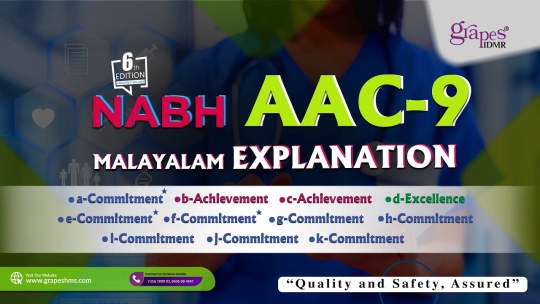#SafetyProgramme
Explore tagged Tumblr posts
Text
AAC 9 NABH 6th Edition: Complete Guide to Imaging Quality Assurance and Safety Programme
Understanding AAC 9: The Foundation of Medical Imaging Excellence
The NABH 6th Edition's AAC 9 standard represents a cornerstone in establishing comprehensive quality assurance and safety programmes for imaging services in healthcare facilities. This critical accreditation standard ensures that medical imaging departments operate with the highest levels of safety, quality, and clinical effectiveness, protecting both patients and healthcare professionals while delivering accurate diagnostic results.

What is AAC 9 and Why Does It Matter?
AAC 9 focuses on creating an established quality assurance and safety programme specifically designed for imaging services. This standard recognizes that medical imaging plays a vital role in modern healthcare diagnosis and treatment, making it essential to maintain rigorous quality controls and safety protocols. The programme encompasses everything from radiation safety measures to clinical appropriateness of imaging procedures, ensuring comprehensive oversight of imaging operations.
youtube
Healthcare facilities implementing AAC 9 demonstrate their commitment to patient safety, clinical excellence, and operational efficiency in their imaging departments. This standard helps organizations minimize risks, improve diagnostic accuracy, and maintain regulatory compliance while fostering a culture of continuous improvement.
Breaking Down the AAC 9 Elements: A Comprehensive Overview
AAC 9.a: Implementation of Quality Assurance Programme
The foundation element requires healthcare facilities to implement a robust quality assurance programme for imaging services. This involves establishing systematic processes for monitoring, evaluating, and improving imaging quality consistently. The programme must be formally documented, regularly reviewed, and actively implemented across all imaging modalities within the facility.
AAC 9.b: Ensuring Appropriateness of Imaging Investigations
This achievement-level element focuses on establishing systems that verify the clinical appropriateness of imaging investigations and procedures. Healthcare facilities must implement protocols that ensure imaging requests align with clinical indications, preventing unnecessary radiation exposure and optimizing resource utilization. This includes developing clinical decision-making tools and guidelines that support appropriate imaging utilization.
AAC 9.c: Periodic Peer Review Process
The programme must address regular internal and external peer review of imaging results using appropriate sampling methodologies. This element ensures that imaging interpretations meet professional standards and helps identify areas for improvement in diagnostic accuracy. The peer review process should be structured, documented, and conducted by qualified professionals with relevant expertise.
AAC 9.d: Clinics-Radiological Meetings
Excellence-level element AAC 9.d requires the establishment of regular clinico-radiological meetings that bring together radiologists, clinicians, and other relevant healthcare professionals. These meetings facilitate multidisciplinary collaboration, improve diagnostic accuracy, and enhance patient care outcomes through collaborative case discussions and knowledge sharing.
AAC 9.e: Documentation of Corrective and Preventive Actions
This commitment element mandates comprehensive documentation of corrective and preventive actions identified through quality assurance activities. Healthcare facilities must maintain detailed records of quality issues, corrective measures implemented, and preventive strategies adopted to avoid recurrence of problems.
Radiation Safety: The Core of AAC 9
AAC 9.f: Radiation Safety Programme Implementation
The radiation safety programme represents a critical component of AAC 9, requiring healthcare facilities to establish comprehensive protocols for radiation protection. This includes developing policies for radiation safety, appointing qualified radiation safety officers, and implementing systematic approaches to minimize radiation exposure for patients, staff, and visitors.
AAC 9.g: Patient Safety Screening
Before any imaging procedure, patients must be appropriately screened for safety risks and contraindications. This element ensures that healthcare providers assess patient conditions, pregnancy status, allergies, and other factors that might affect imaging safety or procedure appropriateness.
AAC 9.h: Radiation Safety and Monitoring Devices
All imaging personnel and patients must use appropriate radiation safety and monitoring devices where applicable. This includes personal dosimeters for staff, lead aprons, thyroid shields, and other protective equipment designed to minimize radiation exposure during imaging procedures.
AAC 9.i: Testing and Documentation of Safety Devices
Radiation safety and monitoring devices require periodic testing with comprehensive documentation of results. This element ensures that protective equipment functions correctly and provides adequate protection for users. Regular testing schedules, maintenance records, and performance documentation are essential components.
Training and Safety Awareness
AAC 9.j: Personnel Training in Safety Practices
Imaging and ancillary personnel must receive comprehensive training in imaging safety practices and radiation safety measures. This training should be ongoing, documented, and tailored to specific roles and responsibilities within the imaging department. Regular updates and refresher training ensure staff members maintain current knowledge of safety protocols.
AAC 9.k: Appropriate Imaging Signage
Proper signage must be prominently displayed in all appropriate locations throughout imaging departments. This includes radiation warning signs, safety instructions, emergency procedures, and other relevant information that helps maintain safety awareness among staff, patients, and visitors.
Implementation Strategies for AAC 9 Compliance
Developing Comprehensive Policies and Procedures
Healthcare facilities should develop detailed policies and procedures that address each element of AAC 9. These documents should be regularly reviewed, updated, and communicated to all relevant personnel. Clear guidelines help ensure consistent implementation and compliance across all imaging services.
Establishing Quality Metrics and Monitoring Systems
Effective AAC 9 implementation requires robust monitoring systems that track quality metrics, safety indicators, and compliance measures. Regular data collection and analysis help identify trends, areas for improvement, and opportunities for enhanced performance.
Creating a Culture of Safety and Quality
Success in AAC 9 implementation depends on fostering a organizational culture that prioritizes safety and quality in imaging services. This involves leadership commitment, staff engagement, and continuous improvement initiatives that support long-term success.
Benefits of AAC 9 Implementation
Healthcare facilities that successfully implement AAC 9 standards experience numerous benefits, including improved patient safety, enhanced diagnostic accuracy, reduced liability risks, and better regulatory compliance. The comprehensive approach to quality assurance and safety creates a foundation for excellence in imaging services.
Conclusion: Achieving Excellence Through AAC 9
AAC 9 represents a comprehensive framework for establishing quality assurance and safety programmes in medical imaging. By addressing all elements systematically, healthcare facilities can achieve excellence in imaging services while ensuring patient and staff safety. The standard provides a roadmap for continuous improvement and operational excellence in medical imaging departments.
#Related Hashtags:#AAC9#NABH6thEdition#MedicalImaging#QualityAssurance#RadiationSafety#HealthcareAccreditation#ImagingSafety#PatientSafety#MedicalQuality#HealthcareCompliance#RadiologyStandards#ImagingQuality#HealthcareSafety#MedicalStandards#NABHAccreditation#QualityManagement#RadiationProtection#ImagingServices#HealthcareExcellence#MedicalDiagnostics#ClinicalQuality#HealthcareImprovement#SafetyProgramme#QualityControl#MedicalCompliance#Youtube
0 notes